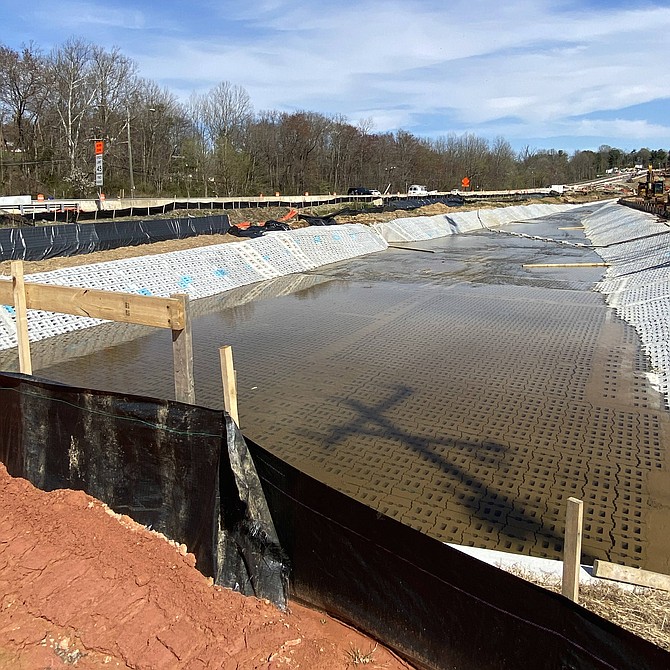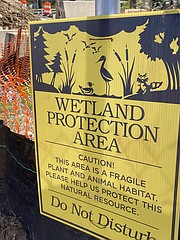Colvin Run as an articulated concrete block channel with the addition of staggered weirs, wooden boards to dissipate the water velocity. Photo by Mercia Hobson.
Part 2 of a series.
Fairfax County Supervisor Walter Alcorn (D-Hunter Mill District) presented a Joint Board Matter with Supervisor John W. Foust (D-Dranesville District) on Tuesday, April 13. The matter concerned a process review of the Route 7 infrastructure project and the environmental impacts by concrete channeling of Colvin Run as it empties into Difficult Run.
“This result is not good for Colvin Run; not good for Difficult Run, nor is it consistent with the best stream management and restoration techniques developed and implemented in dozens of locations around the county,” Alcorn said.
The Board voted unanimously to direct County staff to review the environmental processes undertaken in the Rt. 7 widening project. According to the Joint Board Matter, the staff is to “recommend changes in county, state, and/or federal processes to achieve a more balanced and holistic approach toward minimizing the overall environmental impact on similarly scaled and situated infrastructure projects. Such recommendations could include proposed changes in state or federal law in the Board’s legislative program.”
During his presentation, Alcorn reminded the Board, the Route 7 widening project was well underway. It saw several years of engineering and planning by the U.S. Army Corps of Engineers, Virginia Department of Transportation, Fairfax County Department of Transportation, and other federal, state, and county agencies.
“Unfortunately, inspired by a group of local residents and (as reported) in a Connection Newspapers article, the final outcome is not a good one for Colvin Run where it empties into Difficult Run…In the name of protecting wetlands, the U.S. Army Corps of Engineers approved the one option that was probably the worst option for the stream – putting Colvin Run into a concrete channel,” said Alcorn.
JOINTLY with Supervisor Foust, Alcorn put forth the motion that (County) staff review the environmental processes undertaken in the Route 7 Widening Project that resulted in the concrete channeling of Colvin Run. Chairman Jeffrey C. McKay opened the meeting for discussion. Seeing and hearing none, the ten-member Board voted and unanimously approved the motion.
Kathleen R. Leonard, at Virginia Department of Transportation Communications provided the Connection with a 2012- 2019 chronological description of the Rt. 7 Improvements engineering and planning public meetings and other events. Highlights included the Rt. 7 Working Group Meetings, community and homeowners’ meetings, public notices issued by Virginia Marine Resources Commission, and Virginia Department of Environmental Quality.
Leonard supplied links to meeting minutes, presentations, and permit approvals, including those for Virginia Department of Environmental Quality (VDEQ) Virginia Water Protection, U.S. Army Corp of Engineers Wetland, and Virginia Marine Resource Center (VMRC).
One of the earliest documents VDOT provided was the Nov. 2017 Revised Environmental Assessment of Aquatic Biology. It rated the potential environmental impact between a No-Build Alternative and Build Alternative for Colvin Run, Piney Run, and Difficult Run. The Fairfax County, Stream Protection Baseline Study, was identified as the best available data source relevant to the Study Area. Three monitoring stations were located within or close to the Study Area (Colvin Run, Piney Run, and Difficult Run).
Benthic Macroinvertebrate Community Integrity scored “poor” in Colvin Run and “good” for Difficult Run and Piney Run. Aquatic Habitat scored “poor” for all three stations. Fish Taxa Richness scored “high” for Colvin Run, “moderate” for Difficult Run, and “low” for Piney Run.
According to reported findings, the Build Alternative would result in “minimal impacts” from loss of stream channel, temporary construction impacts, and road operation. The effects would be offset mainly by implementing best management practices and stabilizing Colvin Run.
On July 26, 2019, the Virginia Marine Resources Commission at Fort Monroe, Va., issued a public notice of a 30-day public hearing August 17, 2019, through September 16, 2019, regarding applicant Shirley Contracting to impact 2,609 linear feet of surface waters affecting Colvin Run and Difficult Run in the Potomac watershed.
On Aug. 26, 2019, the Virginia Department of Environmental Quality issued a public notice. The public meeting was not held based on the low number of comments received during the 30-day notice, according to documents provided by VDOT.
ERIC KNUDSEN, a former member of the Rt. 7 Working Group, said he and Tim Thompson, president of the Carpers Farm Homeowners Association in Vienna, which is adjacent to Colvin Run, traveled to Fort Monroe on Tuesday, Sept. 24, 2019, to testify at a hearing of Virginia Marine Resources Commission. Knudsen said they testified about the concrete block channelization of Colvin Run and its sediment flow to Difficult Run as part of the Route 7 Improvements Project between Colvin Run Road and Jarret Valley Drive in Fairfax County. He and Thompson detailed the environmental consequences of channelizing Colvin Run to manage stormwater and funneling it into Difficult Run. He said they voiced opposition to “Option 10-C”, a rip rap channel such as concrete blocks and not a best practice. Knudson said the Army Corp of Engineers did not term the area a “floodplain” but instead a “stable forest.”
“I was arguing that it was a cow pasture, a floodplain that allowed the water to expand and not be funneled into Difficult Run. What they were doing was creating a funnel that would create more turbulence. The fact was that a meandering stream through a floodplain was a whole lot more environmentally safe than a channel into another stream,” said Knudsen. He said they voiced recommendations for three other options. Those were 1, 2, and 3, using stormwater best practices such as meandering streams with shallow pools.
Knudsen said they brought letters in opposition to the proposed plan from Fairfax County addressed to Robert Berg at the Army Corps of Engineers and from Great Falls Citizens Association signed by William Canis. The letters cited the problems 10-C would cause for Difficult Run, which could negatively impact nearby wetlands. According to Knudsen, those on the Virginia Marine Resources Commission told them the letters could not be entered as testimony.
One month later, on October 16, 2019, the Virginia Department of Environmental Quality issued Individual Permit Number 19-0554 signed by David L. Davis, Director, Office of Wetland and Stream Protection to Shirley Construction. It authorized permanent surface water impact on .84 acres palustrine forested wetlands, .90 acres of stream channel, and areas less than .13 acres of combined palustrine scrub-shrub /emergent wetlands and open water on the Rt.7 Improvements from Colvin Run Road to Jarrett Valley Drive. The permittee, Shirley Contracting Company, LLC, would be compensated for the authorized surface water impacts.
The other two required permits followed, October 31, 2019, U.S. Army Corps of Engineers Wetland and November 4, 2019, Virginia Marine Resource Commission.
On July 9, 2020, the Route 7 Working Group held Meeting No. 23. Minutes of the meeting described a Route 7 Project Update for the Colvin Run stream relocation. As part of the update, documents showed a page of proposed “enhanced design elements” along the articulated concrete block channel, the addition of staggered weirs, wooden boards to dissipate the water velocity.
On Friday, April 16, 2021, Leonard provided VDOT’s project overview and update. She said in an email that the foundation of the new stream channel at the approach to Difficult Run is constructed of hollow articulated concrete blocks (ACBs). Those blocks would guard against ongoing erosion and allow, over time as soil was deposited into the vertical cores and spaces in the blocks for vegetation to develop by the water running through the channel.
Looking to future work, Leonard said the project team is at the beginning of the construction phase in the Colvin Run and Difficult Run area. Removal of the eastbound side of the existing Difficult Run bridge has begun. Later this year, the retaining wall between Colvin Run and eastbound Route 7 will be built. She added that an eastbound Route 7 bridge over Difficult Run would be built in late 2021/22.
The Connection has not heard back from other individuals and groups after requests for comments as of press time. The Connection will publish these as we receive them.
VDOT-Provided Documents:
Virginia Marine Resources Commission (VMRC) Permit - November 4, 2019 Copy of VMRC Permit
U.S. Army Corps of Engineers (USACE) Permit - October 30, 2019 Copy of USACE Permit
Virginia Department of Environmental Quality (DEQ) Permit - October 16, 2019 Copy of DEQ Permit
Virginia Department of Environmental Quality (DEQ) Public Notice - August 16, 2019 Copy of Public Notice published in the Fairfax County Times and Virginia Marine Resources Commission (VMRC) Public Notice - July 26, 2019.

